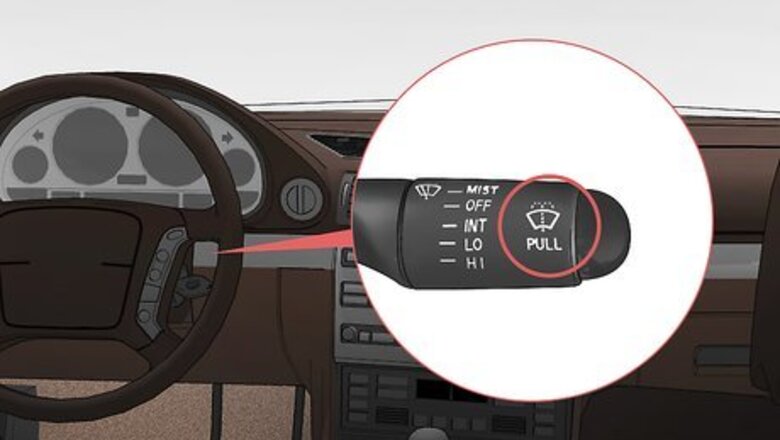
views
Diagnosing the Pump System
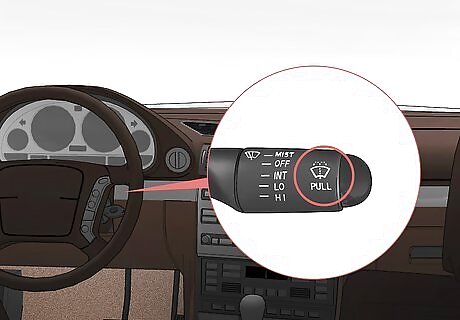
Listen for the pump while turning it on to rule out an electrical issue. Turn on just your vehicle’s battery and locate the button that activates the pump, which is usually on the steering column. Press the button and listen for a humming sound from the pump under your vehicle’s hood. If you don’t hear a sound, there’s either a problem with the fuse, your vehicle’s wiring, or the pump’s internal electronics. Try popping your vehicle’s hood if you have trouble hearing the pump. If you hear your pump humming but you don’t see any fluid coming out from the nozzles, the fluid tank may be empty or there may be a clog. The tubes that are connected to the nozzles may have been disconnected, as well. If the pump doesn’t work at all, you’ll have to check the pump’s electrical system to see if the pump is faulty.
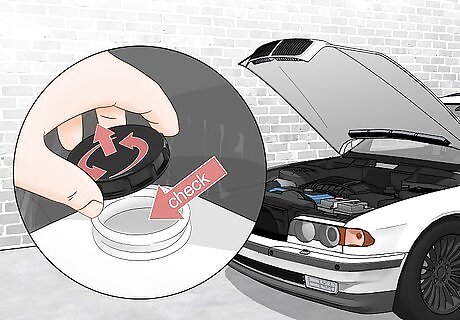
Inspect the washer tank to see if it’s empty. Open your vehicle’s hood and look for the circular tank cap that has a picture of windshield wipers on it. Unscrew the cap and look inside the tank to check the fluid levels. Typically, you’ll see a blue or purple fluid inside of the tank. If you don’t see anything or the levels are close to the bottom, then it’s time to refill the tank. Shine a flashlight into the tank if you have trouble seeing into it. If you see dit or other contaminants inside of the tank, they may also cause a clog and should be flushed out.Variation: If you’re troubleshooting for a rear windshield, there may be a separate tank in the back of your vehicle. Check your vehicle’s manual if you have trouble locating it.

Look for cracks and leaks in the hoses or tank. Open your vehicle’s hood and prop it up so it doesn’t fall down. Locate where the hoses connect to the plastic nozzles on your hood and run your fingers along its length. Visually inspect the hose for any damage or cracks to ensure it’s not leaking. Trace the hoses back from the other nozzles as well. If you see any damage, you’ll need to have the parts replaced. If you have trouble locating the hoses, check the manual or take your vehicle in to a mechanic for your repairs. Replacing hoses and washer tanks usually require you to remove parts, so it may be difficult to do at home if you don’t have experience working on vehicles.
Refilling the Tank
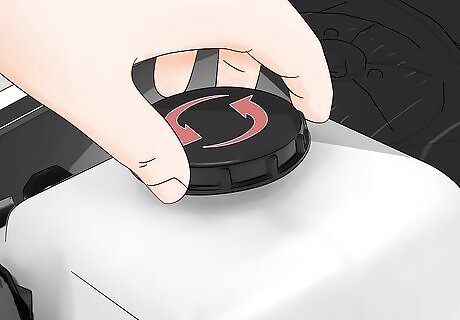
Unscrew the tank’s cap. Pop the hood on your vehicle so you can access the tank. Locate the tank’s spout, which has a cap with a picture of windshield wipers on it. Turn the cap counterclockwise to loosen and remove it. Set the cap aside somewhere it won’t get lost. The tank location varies between vehicles, so check the manual if you have trouble locating it. Check for a compartment in or around your trunk if you’re refilling a tank for a rear windshield.

Pour windshield washer fluid up to the tank’s fill line. Windshield washer fluid is usually a mixture of water and alcohol that cleans off dirt and dries off quickly. Open the bottle and pour it directly into the tank’s spout. If you’re worried about spilling the fluid, put a funnel in the spout. Keep pouring the fluid into the tank until it reaches the horizontal fill line on the side. You can buy windshield wiper fluid from convenience or auto supply stores. Typically, washer tanks are clear so you can easily see the fluid level from the outside. It’s okay if you don’t fill the wiper fluid up to the fill line since the pump attaches to the bottom of the tank.Tip: If you live in an area with freezing temperatures, buy wiper fluid that’s made with a low freezing point. That way, it won’t harden in the tank or hoses.
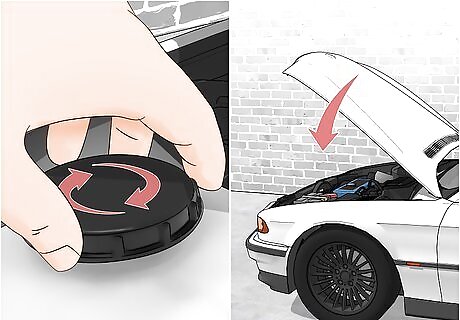
Seal the tank and close the hood. Put the cap back on the spout and turn it clockwise until it feels tight. Avoid forcing the cap on any further, or else you could damage or crack the tank. Lower your vehicle’s hood so the nozzles spray your windshield when you test them out. Never leave the tank uncapped since the liquid could easily spill or evaporate.
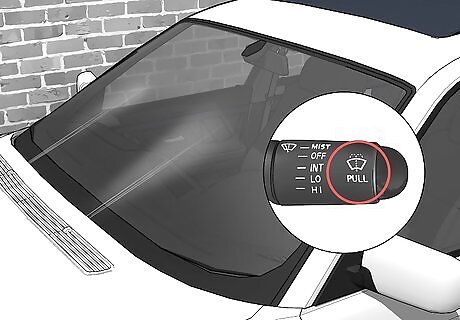
Test the washer to see if fluid sprays out. Turn on your vehicle’s battery without starting the engine. Press the button that activates the windshield wiper fluid and hold it down for 2–3 seconds. It’s normal for the fluid to sputter out at first, but it should form a steady stream or fan pointed toward the center of your windshield when the pump works properly. If you still don’t see fluid coming out from the nozzles, there may be a clog or an issue with the electronics.
Flushing out Clogs
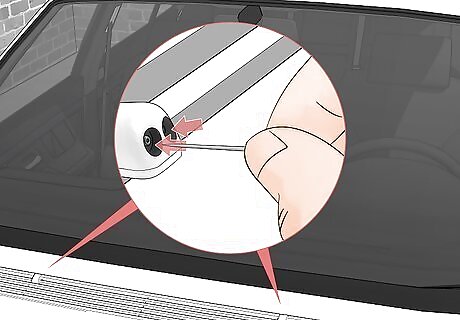
Scrape dirt out from the exterior nozzles with a safety pin. Locate the 2–3 nozzles along the front of your windshield where the fluid normally sprays from. Stick the point of a safety pin around the nozzle opening to break apart any dirt or stuck-on material. Wipe the safety pin off with a shop cloth frequently to clean it off. Try to break off as much debris as you can. You could also use a paperclip or a staple if you don't have a safety pin. The nozzles may be attached to the windshield wipers on your vehicle. Dirt can rinse back into the nozzle after you spray it and clog it. Try the washer pump after clearing the nozzles to see if it fixed your problems.
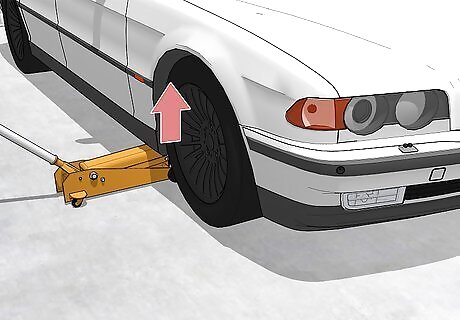
Raise your vehicle up onto jack stands. Find a sturdy jacking point on the side of your vehicle’s frame to place the jack. Pull the handle down on your lift your car off of the ground so you have enough room to get underneath it. Brace the frame with jack stands to keep the vehicle from falling down. Jack up the other side of your vehicle and place 2 more jack stands under the frame. Never work underneath your vehicle while it’s on the jack since it could easily slip.
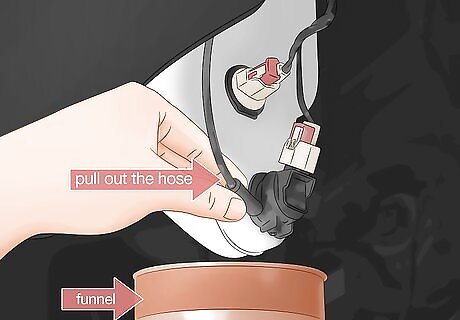
Disconnect the hose on the pump to drain the tank. Look for the washer pump, which looks like a black cylinder connected to the bottom of the washer’s clear tank. Locate the hose leading from the pump back up into your vehicle. Place a bucket underneath the hose and pull out the hose to drain the tank. Try removing one of your vehicle’s wheels if it’s in the way of your work. You can try saving the wiper fluid if it doesn’t have any dirt or debris. Try funneling the fluid into a spare bottle with a funnel instead of a bucket.
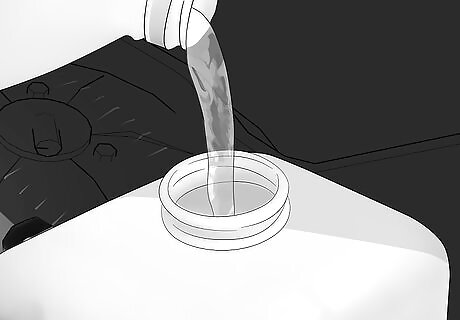
Pour clean water through the tank to rinse out dirt and debris. Place an empty bucket underneath the pump to catch any runoff. Open your vehicle’s hood and unscrew the cap for the tank. Fill a second bucket with warm water and slowly pour it into the wiper fluid tank so it drains through the system. Keep pouring water through the tank until it comes out clean. Avoid reusing the same water when you flush out the tank since you may reintroduce the dirt or debris.
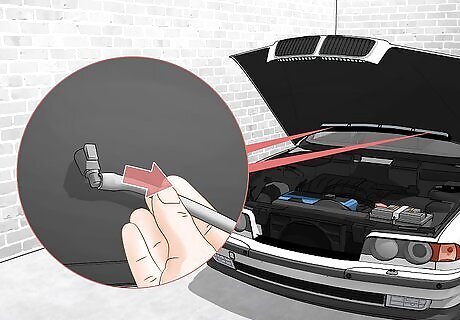
Unplug the hoses from the nozzles. Locate the L-shaped ends for the nozzles connected to the hoses on the underside of your vehicle’s hood. Pinch the end of the hose and pull it straight off of the nozzle to disconnect it. Leave the nozzle on the hood and let the hose hang freely during your repairs. Disconnect the hoses on the rest of the nozzles. You usually won’t need tools to detach the hoses, but you may need a wrench if clamps secure the hoses to the nozzles.
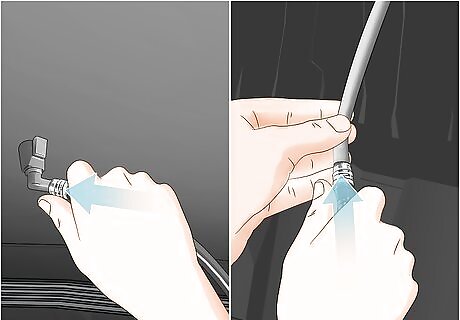
Blow compressed air through the hoses and nozzles. Put the compressed air’s nozzle into the end of the hose and slide it in as far as you can. Press down on the button to force the air through the hose. If there’s any dirt or buildup inside, it will push out from the other side. Spray from each end of the hose to ensure you remove all of the material. Then put the compressed air in the back of the washer’s nozzles and blow air through them as well. You can buy a bottle of compressed air from your local hardware store.Warning: Avoid spraying compressed air from the exterior ends of the nozzles. You could damage the valves that prevent dirt and other materials from getting into the hoses.
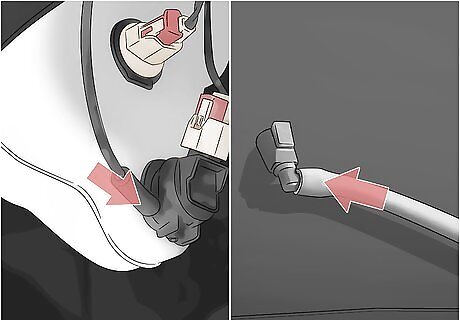
Reconnect the hoses to the pump and nozzles. Pinch the end of the hose on the underside of your hood and push it back onto the nozzle connection. Slide the hose as far onto the nozzle as you can so it’s less likely to leak. Attach the other hoses to the rest of the nozzles. Then plug the bottom end of the hose back into the side of the pump so the tank doesn’t leak anymore.

Refill the tank to test your wipers. Open the washer tank and fill it with wiper fluid up to the fill line. Close your vehicle’s hood before you turn on the battery. Hold the windshield button down for about 3–4 seconds so the fluid starts coming out from the pump. It’s normal for the wiper fluid to sputter when you first start spraying it, but it should form a consistent stream within a few seconds. If your windshield washer still doesn’t work, there may be an issue with the electrical system.
Testing the Electrical Connections
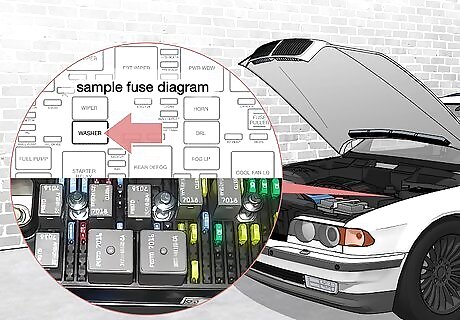
Locate the fuse that controls the washer pump. Find your vehicle’s fuse box underneath the hood near the front fender. Read the fuse diagram on the cover to locate the fuse that controls the washer pump. Take the cover off of the fuse box and find the corresponding fuse. Check your vehicle’s manual if you have trouble locating the fuse box.Tip: Typically, the washer pump is on the same fuse as the motors that control the wiper arm. If they share a fuse and the wiper arms still move when you turn them on, then you have a faulty pump.
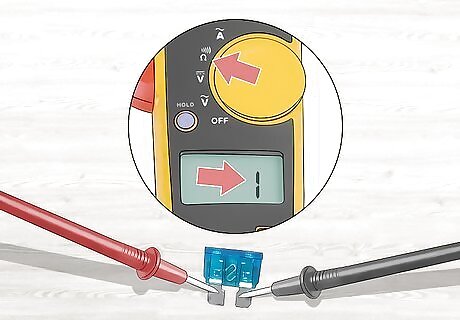
Test the fuse with a multimeter for a continuity below 1 ohm. Set your multimeter to the lowest ohms setting (Ω) to measure the continuity across the fuse. Pull the fuse out from your fuse box and set it on a flat surface. Place one probe against fuse’s left prong and the second probe against the other prong. Look for a reading that’s less than 1 on the multimeter to ensure that it has continuity. If you get an “OL” or “OPEN” reading on the multimeter, the fuse has blown. Take the old fuse to an auto supply store so you can buy a replacement.
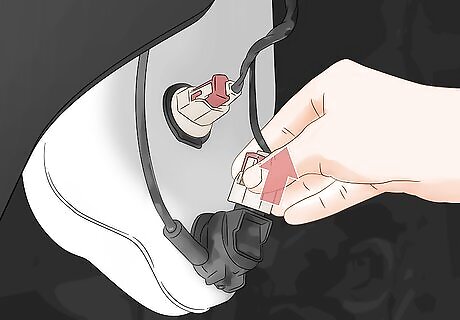
Unplug the wire connector from the wiper pump. Keep your vehicle’s engine and battery turned off. Locate the pump on the bottom of the washer tank, which is usually near the back of the engine well or near the front fender. Look for a wire connector, which looks like a black box attached to the side of the pump with wires leading back to the fuse box. Grab the base of the box and pull it straight out from the pump to disconnect it. It may be easier to access the pump if you jack up your vehicle or remove one of the front tires.
Plug a test light into the connector leading back to the fuse box. Test lights only turn on if they have the correct voltage running through them. Plug the prongs of a 12-volt test light into the connector and push it in as far as you can. Let the light dangle near your pump so you can easily see it while you test the wiring. You can buy test lights from your local hardware store.
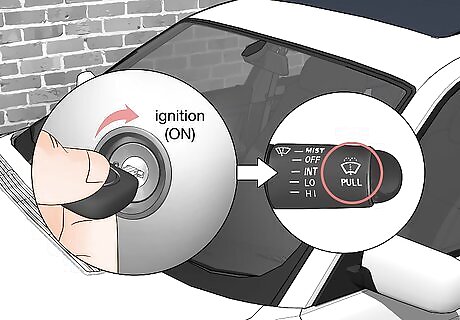
Turn on your vehicle’s battery and operate the windshield pump. Turn the key in the ignition so the battery starts and the engine stays off. Press down on the windshield washer button and keep it held down. The wipers and washer won’t operate, but it will activate the washer’s fuse. If you have trouble seeing the light while pressing the button, ask a helper to press the button for you while you watch the light.
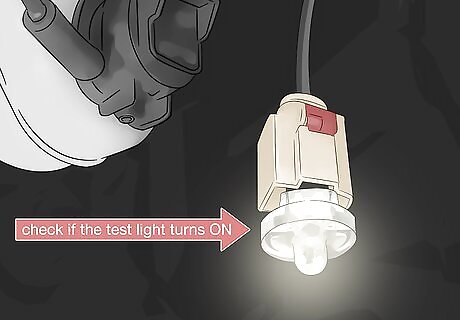
Replace the pump if the test light turns on. As you hold down the button, look at your test light to see if it turns on. If it does, your vehicle’s wiring works properly and there’s a problem with your pump. Take it to a mechanic to have it replaced. If the light doesn’t turn on, then there may be a problem with the switch or your vehicle’s wiring. See a mechanic since it can be very difficult to repair your car’s electrical system on your own.
Repositioning the Nozzle
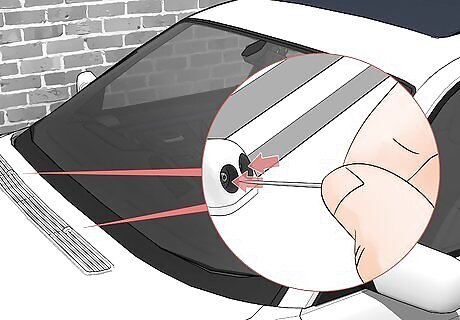
Stick a safety pin into the nozzle’s hole. Choose a safety pin or a tool that’s narrow enough to fit into the nozzle’s exterior hole. Push the pin into the hole by about ⁄2 inch (1.3 cm) so you can control the nozzle easier. You may be able to find a special tool made for positioning windshield nozzles. You can buy them for about $5 USD from an automotive supply store.

Move the pin to aim the nozzle at the middle of your windshield. Move the pin up, down, left, or right to adjust the direction the nozzle sprays. Try to move the nozzle so the spray lands in the center of your windshield so your wipers spread the fluid evenly. Only make small adjustments to the nozzle direction since it may spray further than you expect. Don’t try to force the nozzle to move if you feel resistance, or else you may break the nozzle.

Test your washer to ensure the fluid spreads evenly. Turn on your vehicle’s battery and press the windshield wiper button. Keep holding the button down until the wiper fluid sprays on your windshield. If it doesn’t land in the middle of your windshield, make a mental note of where you need to move it so you can make your adjustment from there. If your nozzle sprays too high or low, the fluid may miss your windshield completely.




















Comments
0 comment